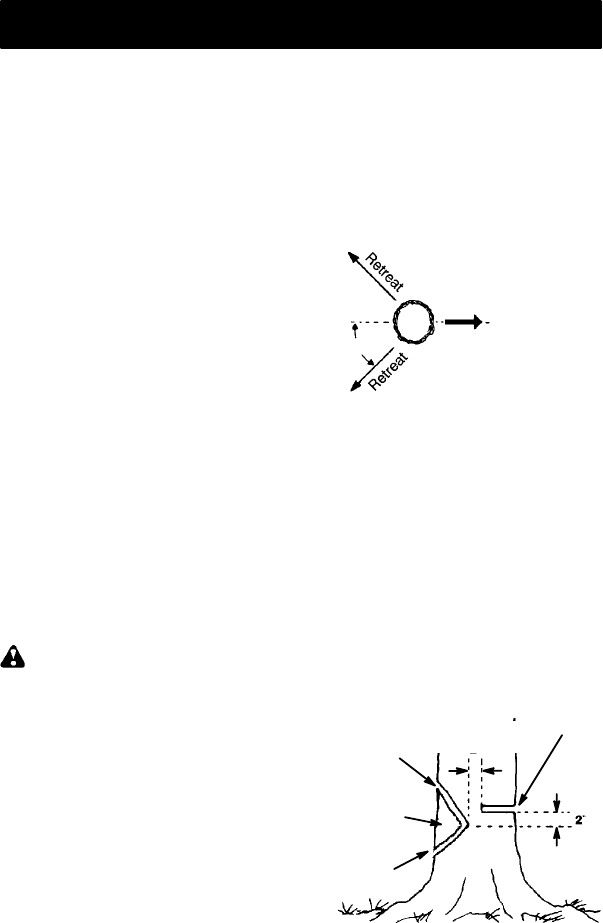
11
CUTTING METHODS
IMPORTANT POINTS
S Check chain tension before first use and
after 1 minute of operation. See CHAIN
TENSION in the ASSEMBLYsect ion.
S Cut woodonly. Do notcut metal,plastics,
masonry, non-wood building materials,
etc.
S Stop the saw if the chain strikes a foreign
object. Inspect the saw and repair or re-
place parts as necessary .
S Keep the chain out of dirt and sand. Even a
small amount of dirt will quickly dull a chain
andthusincrease th epossibility o fkickback.
S Practicecutting afew smalllogs usingthe
followingtechniques togetthe“feel” ofus-
ing your saw before you begin a major
sawing operation.
S Squeeze the throttle trigger andallowthe
engine to reach full speed before cutting.
S Begin cutting with the saw frame
against the log.
S Keeptheengine atfullspeed theentire
time you are cutting.
S Allowthechaintocutforyou.Exertonly
light downward pressure. If you force
thecut,damagetothebar,chain,oren-
gine can result.
S Release the throttle trigger as soon as
the cut is completed, allowing the en-
gine to idle. If you run the saw at full
throttlewithoutacuttingload,unneces-
sary wear can occur to the chain, bar,
and engine.
S Toavoidlosingcontrolwhencutiscom-
plete,d onotputpressureonsawatend
of cut.
S Stop the engine before setting the saw
down after cutting.
TREE FELLING TECHNIQUES
WARNING: Check for broken or
dead branches which can fall while cutting
causingserious injur y. Donotcutnearbuild-
ingsor electricalwiresifyoudonotknowthe
directionoftreefall,norcutatnightsinceyou
will not be ale to see well, nor during bad
weathersuchasrain, snow,orstrongwinds,
etc. Ifthetreemakes contact with anyutility
line, the utility company should be notified
immediately .
S Carefullyplanyoursawingoperationinad-
vance.
S Cleartheworkarea. Youneedacleararea
allaroundthetreesoyoucanhavesecure
footing.
S Study the natural conditions that can cause
the tree to fall in a particular direction.
Natural conditions that can cause a tree to
fall in a particular direction include:
S The wind direction and speed.
S The lean of the tree. The lean of a tree
might not be apparent due to uneven or
slopingterrain. Useaplumborleveltode-
termine the direction of tree lean.
S Weight and branches on one side.
S Surrounding trees and obstacles.
Look for decay and rot. Ifthetrunk isrotted,
it can snap and fall toward the operator .
Check for broken or dead branches which
can fall on you while cutting.
Make sure there is enough roomfor thetreeto
fall. Maintain a distance of
2-1/2 tree lengths
from the nearest person or other objects. En-
gine noise can drown out a warning call.
Remove dirt, stones, loose bark, nails, sta-
ples,andwirefromthetreewherecutsareto
be made.
Planaclearretreat pat hto therearanddiag-
onal to the line of fall.
Direction of Fall
45_
Plan a clear retreat path
FELLING LARGE TREES
(6 inches in diameter or larger)
The notch methodis used to f elllarge trees.
Anotchiscutonthesideofthetreeinthede-
sired direction of fall. After a felling cut is
made on the opposite side of tree, the tree
will tend to fall into the notch.
NOTE: If the tree has large buttress roots,
removethembeforemakingthenotch. Ifus-
ing saw toremove buttress roots, keep saw
chainfromcontactinggroundtopreventdull-
ing of the chain.
NOTCH CUT AND FELLING THE
TREE
S Make notch cut by cutting the top of the
notch first. Cut through
1/3 ofthediameter
ofthetree.Nextcompletethenotchbycut-
ting the bottom of the notch. See illustra-
tion. Once the notch is cut, remove the
notch of wood from the tree.
Notch
First cut
Second cut
Final cut here. 2 inchesabove
center of notch.
S After removing the wood from the notch,
make the felling cut on the opposite side of
thenotch.Thisisdoneby makingacutabout
two inches higher than the center o f the
notch. T his will leave enough uncut wood
between the felling cut a nd thenotch to f orm
a h inge. This hinge will helpprevent thetree
from falling in the wrong direction.


















